Adding a Numeric Combination Graph
This section discusses the steps to create the numeric combination graph using the following sample dataset, where:
cos = COS([deg]*2/360*Pi)
sin = SIN([deg]*2/360*Pi)
|
Auto Key |
cos |
deg |
sin |
|
1 |
1.00 |
0.00 |
0.00 |
|
2 |
0.98 |
10.00 |
0.17 |
|
3 |
0.94 |
20.00 |
0.34 |
|
4 |
0.87 |
30.00 |
0.50 |
|
5 |
0.77 |
40.00 |
0.64 |
|
6 |
0.64 |
50.00 |
0.77 |
|
7 |
0.50 |
60.00 |
0.87 |
|
8 |
0.34 |
70.00 |
0.94 |
|
9 |
0.17 |
80.00 |
0.98 |
|
10 |
0.00 |
90.00 |
1.00 |
|
11 |
-0.17 |
100.00 |
0.98 |
|
12 |
-0.34 |
110.00 |
0.94 |
|
13 |
-0.50 |
120.00 |
0.87 |
|
14 |
-0.64 |
130.00 |
0.77 |
|
15 |
-0.77 |
140.00 |
0.64 |
|
16 |
-0.87 |
150.00 |
0.50 |
|
17 |
-0.94 |
160.00 |
0.34 |
|
18 |
-0.98 |
170.00 |
0.17 |
|
19 |
-1.00 |
180.00 |
0.00 |
Steps:
1. The numeric combination settings pane
is displayed after clicking the Options
 button or the Visualization
Title (i.e., Numeric Combination):
button or the Visualization
Title (i.e., Numeric Combination):
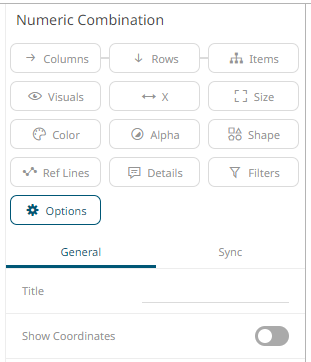
2. Set the following property:
|
Setting |
Description |
|
Show Coordinates |
Determines whether the graph coordinates (i.e., X-Y plots, or Date/Time-Y plots) on mouse over are displayed in the visualization. Tap the slider to turn it on. |
3. To build the hierarchical structure in the numeric combination graph, drag text columns to the Breakdown Items drop area (e.g., Auto Key).
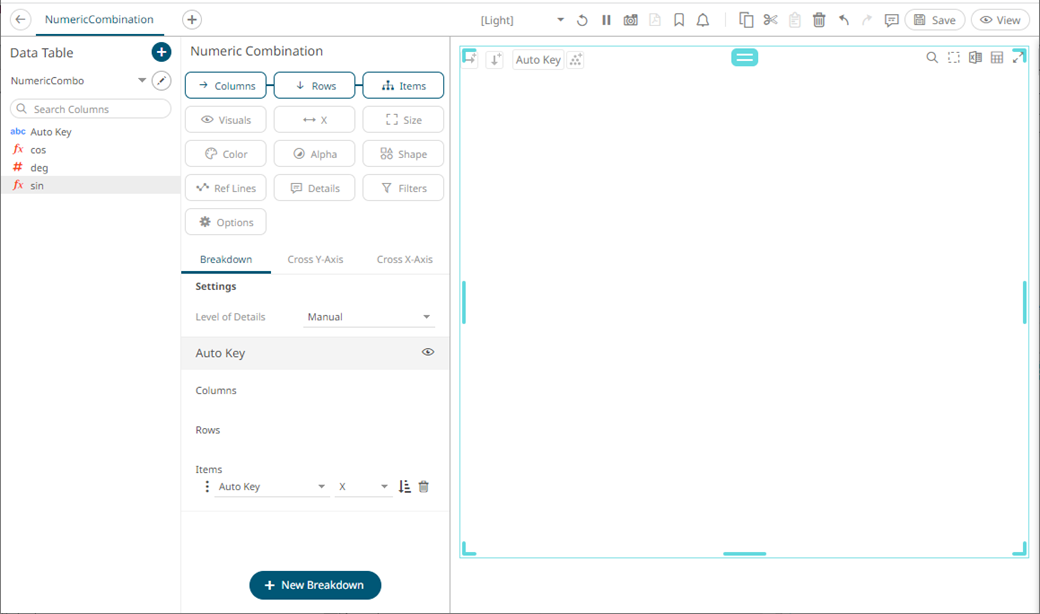
4. To set the X-axis, drag numeric columns from the Data Table pane to the X variable drop area.
For this sample visualization, the deg column will be the used as the height variable.

5. You can opt to drag columns to the Size, Color, Alpha, Shape, Reference Lines, and Details drop area.
6. Continue designing the visualization by dragging numeric columns from the Data Table pane to the Visuals variable drop area.
The column (e.g., sin) is added under the Visualizations tab list and, by default, uses the Line graph and the Left Y-Axis alignment.
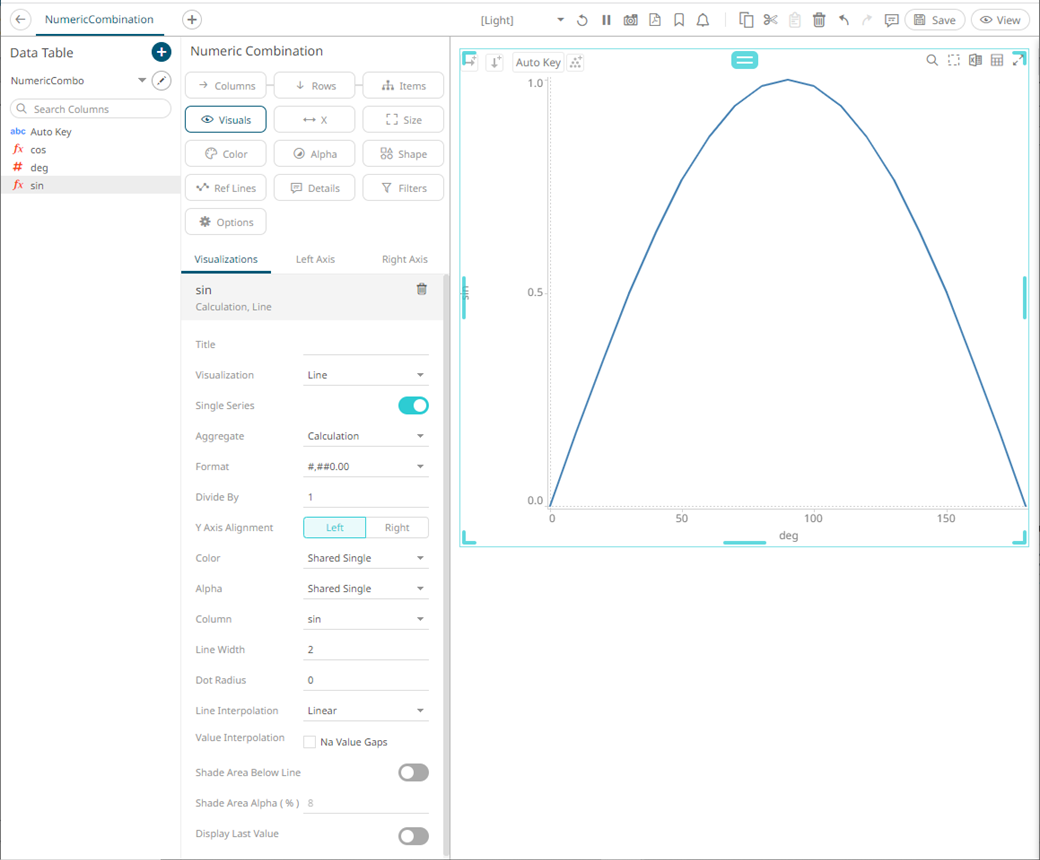
The graph displays a single series based on the column added in the breakdown.
7. The properties that you can set will depend on the visualization type that you will add.
The general settings include:
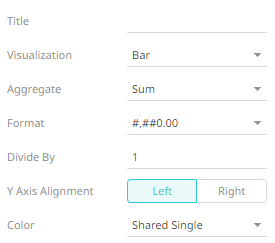
|
Setting |
Description |
|
Title |
Title of the visualization. |
|
Visualization |
If the visualization is incorrect, instead of deleting, you can just select another one in the Visualization drop-down list. The settings pane will be changed to display the corresponding properties of the selected visualization. |
|
Aggregate |
Aggregation method to be used. Default is Sum. |
|
Format |
The format that numbers will be displayed in. Panopticon uses the same formatting rules as MS Excel. |
|
Divide By |
Select the Divide By value to divide a number: · 1 · 1000 (by a thousand) · 10000 · 1000000 (by a million) · 1000000000 (by a billion) |
|
Y Axis Alignment |
The Y-Axis alignment: Left or Right. |
|
Color |
The Color variable that will be used for the column: · None · Shared Single · Custom Single · Column added to the Column variable |
|
Column/Value Column |
The column used for the visualization. If the dragged column is incorrect, instead of deleting, you can just select another column in the Column/Value Column drop-down list. |
8. Visual members can be set to display any of the following visualizations:

· Line
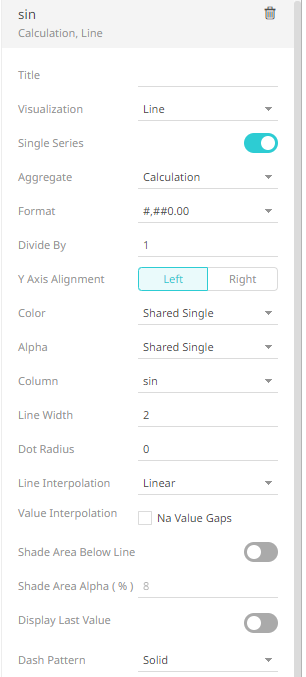
Additional settings include:
|
Setting |
Description |
|
Single Series |
Determines whether to use all columns in the breakdown to create a single series or if one column should be used to divide the data into multiple series. |
|
Alpha |
Select the Alpha value. |
|
Line Width |
Specifies the line width in pixels. |
|
Dot Radius |
Specifies the radius of each data point in pixels. |
|
Line Interpolation |
Specifies whether the line is Stepped, Linear, or Smooth interpolation. |
|
Value Interpolation Time Gaps |
Determines whether time axis gaps (Working Week/Time) are interpolated. |
|
Value Interpolation Na Value Gaps |
Determines whether Na value (or missing) gaps are interpolated. |
|
Shade Area Below Line |
Defines that alpha shades are applied between the lines and the zero Y grid line. |
|
Shade Area Alpha (%) |
Specifies the alpha (transparency) of the shaded area, expressed in percent 0-100 of the alpha value currently set on the line. |
|
Display Last Value |
Determines if the flag of the last value will be displayed. Once enabled, the Show Last Value Title is displayed.
Check the box to display the title of the last value in the flag. |
|
Dash Pattern |
Specifies the line pattern. Available options are: · Dotted · Dashed · Solid |
Sample 1. Single Series is enabled and the Color is set to Custom Single (#2580bd).
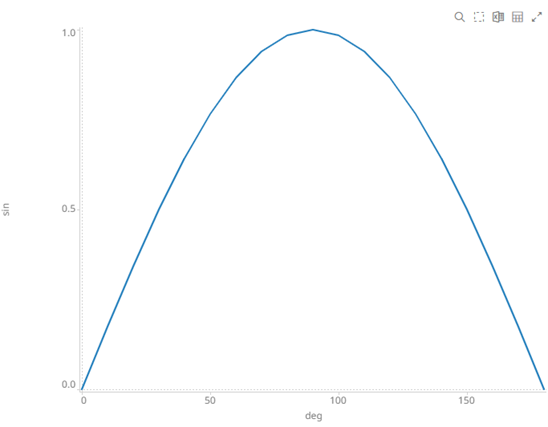
· Scatter
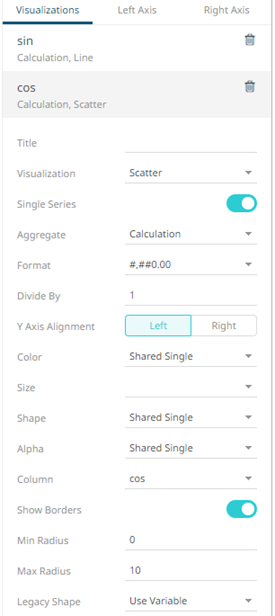
Additional settings include:
|
Setting |
Description |
|
Single Series |
Determines whether to use all columns in the breakdown to create a single series or if one column should be used to divide the data into multiple series. |
|
Size |
Select the Size variable that will be used. |
|
Shape |
Select the Shape value. |
|
Alpha |
Select the Alpha value. |
|
Show Borders |
Determines whether a border is drawn around each scatter point. |
|
Min Radius |
The minimum radius in pixels of the scatter point. |
|
Max Radius |
The maximum radius in pixels of the scatter point. |
|
Legacy Shape |
Allows older workbooks to be updated and use the shape variable. Default is Use Variable. Other shapes can also be selected.
|
Sample 2. Single Series is enabled in the Line and Scatter graphs. In addition, in the Scatter graph, the Color is set to Custom Single (#bb2525).
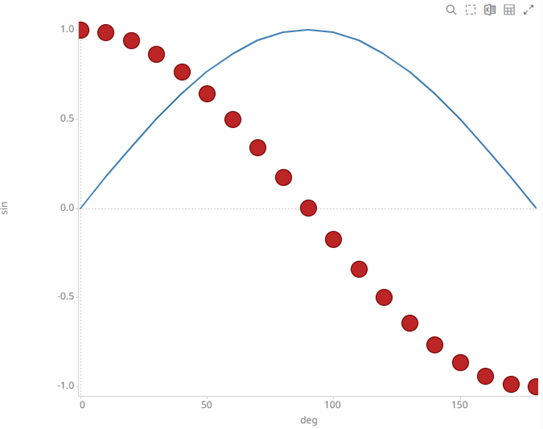
· Spread

Additional settings include:
|
Setting |
Description |
|
Reference Column |
The field that will be used as the reference line data series. |
|
Line Width |
Specifies the width in pixels of the Spread Graph data series lines. |
|
Alpha |
Select the Alpha value. |
|
Spread Color Alpha |
Specifies the level of color transparency/opacity for the Positive and Negative Spread colors. The value is from 0 to 255 with the default set to 128. |
|
Line Interpolation |
Specifies the interpolation mode as Linear, Stepped, or Smooth. |
|
Value Interpolation Na Value Gaps |
Determines whether Na value (or missing) gaps are interpolated. |
|
Value Line Color |
Specifies the color of the value line data series. |
|
Reference Line Color |
Specifies the color of the reference line data series. |
|
Positive Spread Color |
Specifies the color when the spread between the value and reference is positive. |
|
Negative Spread Color |
Specifies the color when the spread between the value and reference is negative. |
Sample 3. Single Series is enabled in the Line graph. In addition, in the Spread graph, the Value Column is set to the cos column, and the Reference Column to the sin column.
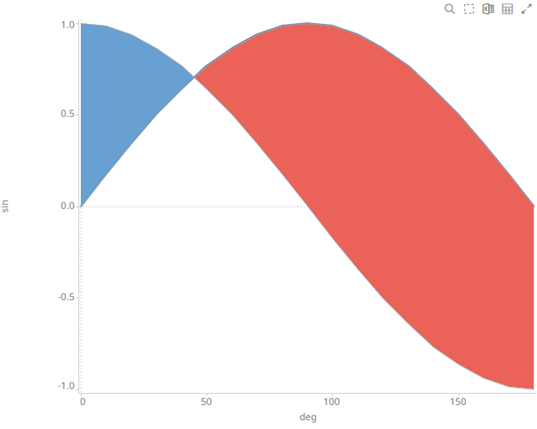
· Price Band
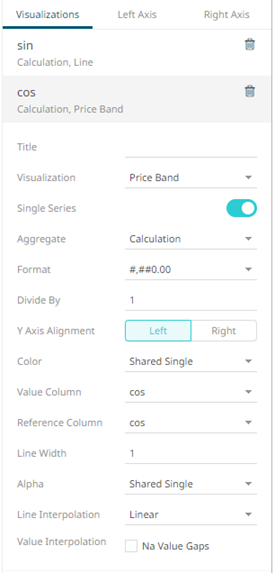
Additional settings include:
|
Setting |
Description |
|
Single Series |
Determines whether to use all columns in the breakdown to create a single series or if one column should be used to divide the data into multiple series. |
|
Reference Column |
The field that will be used as the reference line data series. |
|
Line Width |
Specifies the width in pixels of the Spread Graph data series lines. |
|
Alpha |
Select the Alpha value. |
|
Line Interpolation |
Specifies the interpolation mode as Linear, Stepped, or Smooth. |
|
Value Interpolation Na Value Gaps |
Determines whether Na value (or missing) gaps are interpolated. |
Sample 4. Single Series is enabled in the Line and Price Band graphs. In addition, in the Price Band graph, the Color is set to By Sign, the Value Column is set to the cos column, and the Reference Color to the sin column.
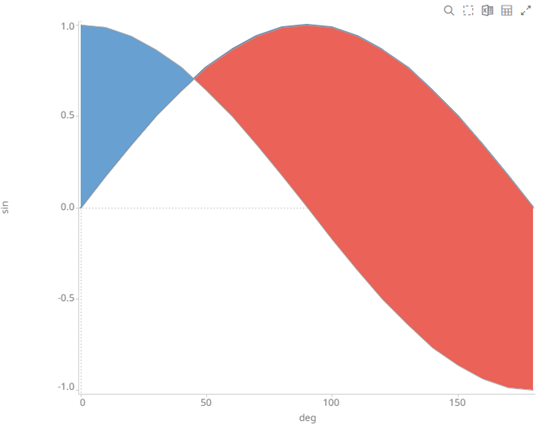
· Bar
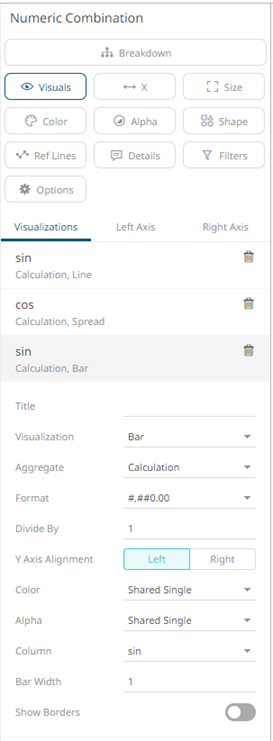
Additional settings include:
|
Setting |
Description |
|
Alpha |
Select the Alpha value. |
|
Bar Width |
Specifies the width in pixels for each bar. |
|
Show Borders
|
Determines whether borders are drawn around bars. These are only visible if the Bar Width is greater than 1 pixel. |
Sample 5. Single Series is enabled in the Line graph. In addition, in the Bar graph, the Column is set to the sin column, the Color to the deg column, and the Bar Width to 2.
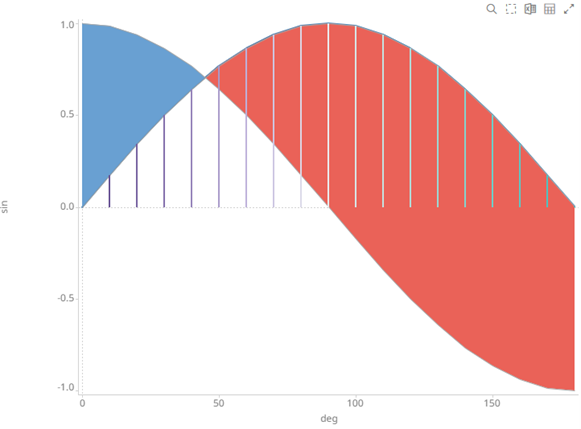
· Stacked Bar or Grouped Bar
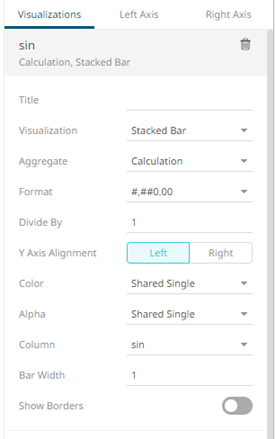
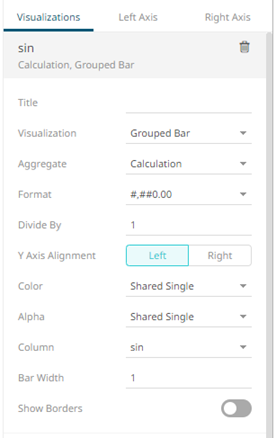
Additional settings include:
|
Setting |
Description |
|
Bar Width |
Specifies the width in pixels of each bar. NOTE: This is overridden when a column is added in the Size variable. Consequently, the width of the bars will be based on the comparison of their size in relation to where they are located on the X axis. |
|
Show Borders |
Specifies whether a border is drawn around bars. These are only visible if the Bar Width is greater than 1 pixel. |
· Stack
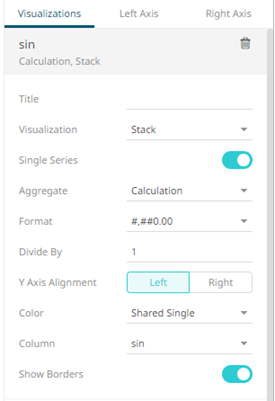
Additional settings include:
|
Setting |
Description |
|
Single Series |
Determines whether to use all columns in the breakdown to create a single series or if one column should be used to divide the data into multiple series. |
|
Show Borders |
Specifies whether a border is drawn around stacks. |
9. The numeric combination visualization includes an expanded axes pane, which includes specification of the properties for both the Left and Right Y axes.
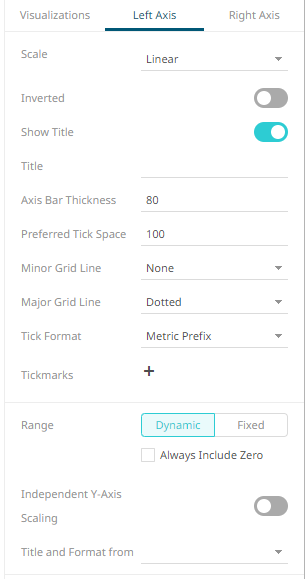
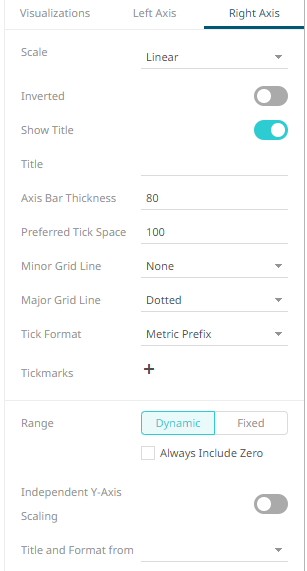
Select or specify the following properties:
|
Setting |
Description |
|
Scale |
Determines whether the scale of the axis is Linear, Log, or Power. · Linear – a change between two values is based on addition e.g., 30, 60, 90, 120, 180, etc. · Log - a change between two values is perceived on the basis of the ratio of the two values or based on multiplication. Once selected, the Base control displays with the value of the common base for the logarithmic scale (i.e., 10).
For example: log10(x) represents the logarithm of x to the base 10 e.g., 1, 10, 100, 1000, etc. You can opt to enter a new Base
value then click NOTE: Value cannot be lower than 2. · Power – Works according to the SIGN(MEASURE)*LOG10(MAX(1, ABS(MEASURE))) formula. Works like the Log scale except it can handle negative values and every value between -1 and 1 is set to 0. For example for values between -100 and 100, the axis will be: -100, -10, 0, 10, 100 |
|
Inverted |
Determines whether the Y or Height axis is inverted. |
|
Show Title |
Displays an Axis Title label. When enabled, you can opt to enter a custom Title for the axis which will override the title of the visualization variable. |
|
Axis Bar Thickness |
The margin in pixels for the axis. If set to zero, the axis is removed. |
|
Preferred Tick Space |
The preferred space in pixels between the minor grid lines across the axis. |
|
Minor Grid Line |
How minor grid lines are drawn across the axis. Allowed values: · None · Dotted · Dashed · Solid |
|
Major Grid Line |
How major grid lines are drawn across the axis. Allowed values: · None · Dotted · Dashed · Solid |
|
Tick Format |
Set to From Variable to use the format string that is on the current variable displayed in the axis. Set to Metric Prefix to format the Tick labels in the numeric axes using the metric prefixes. |
|
Tickmarks |
Click
Enter the Value and the Label. Click
|
|
Range |
The visible range for the Left and Right Y-axis variables can either be calculated dynamically (Dynamic Range) or set between predetermined limits by selecting Fixed Range. This enables the Min and Max text boxes and populates them with default values taken from the data set. |
|
Independent Y-Axis Scaling |
Determines whether to have each visualization Y-axis in a cross tab automatically scaled independent of the others. |
|
Title and Format From |
The title and format of the Left and Right Axes based on the selected fields. |




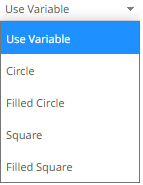

 .
.